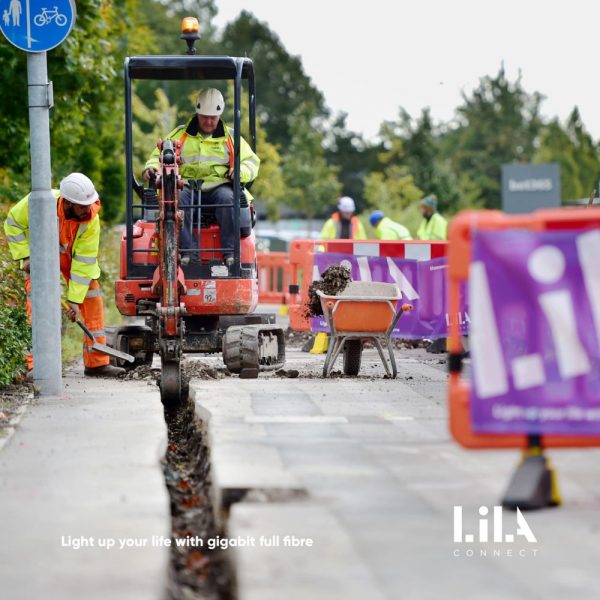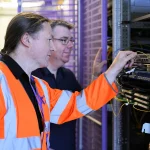VX Fiber – What UK FTTP Broadband Projects Can Learn from Sweden

In a new ISPreview.co.uk interview the Chairman of Swedish operator VX Fiber, Mikael Sandberg, has helped to illuminate the “stark difference in attitude towards fibre in the UK compared with Sweden” and highlights some of the ways in which FTTP broadband deployments on this side of the channel could be improved.
At present VX Fiber (inc. subsidiary LilaConnect) is deploying a new gigabit-capable Fibre-to-the-Premises (FTTP) broadband network across several areas of the UK, including in the Staffordshire city of Stoke-on-Trent (100,000 premises – here), the town of Colchester in Essex (8,000 premises – here), parts of London (3,000 premises via Prime Fibre) and the towns of Crewe and Nantwich in Cheshire (here). Bristol is expected to follow soon.
However, VX Fiber itself hails from Sweden, which is one of Europe’s most well-developed markets for full fibre network coverage. The country started building fibre optic networks way back in the late 1990s, and in 2009 it set out a strategy for ensuring that 90% of premises could access 100Mbps+ speeds by 2020; the bulk of which would be FTTP. At around the same time the UK was just starting to focus on a hybrid fibre (FTTC / HFC) dominated rollout.
Advertisement
Some 81% of Sweden now has access to a full fibre network (here), which compares with around 24% in the UK today (here), and over 60% of homes in Sweden have connected to the service. But despite the slow start the UK has, over the past three years, started to build FTTP at a much more rapid pace – thanks to various policy / regulatory changes, tax breaks and investment schemes.
Suffice to say that we were keen to understand more about what VX Fiber’s Chairman, Mikael Sandberg, had to say about the differences in fibre strategy between both countries.
A Little Context
Mikael himself has a long history of working with FTTP networks, having done two Master’s degrees on them in the late 1980s/early 1990s and later becoming the MD of broadband ISP Bostream in 2001 (this was sold to Bredbandsbolaget in 2004), before helping to found and lead the Quadracom Group in 2005.
In 2014, Quadracom was sold to TeliaSonera (the Swedish/Finnish incumbent), and as part of that deal Mikael was not allowed to engage in any competitive ventures in Sweden for a period of three years, so he worked with a team to set-up VX Fiber (then known as VenturaNext) and focused on other markets instead, such as the UK.
Advertisement
VX Fiber’s core business is being an open access fibre operator and nowadays also a fibre builder and investor. As a fibre builder and investor, VX Fiber works in partnership with other fibre owners to deploy large scale fibre networks, which it then operates. As a fibre operator, VX Fiber will invest hardware and software, monitor and control the network and engage third party Service Providers.
Opinions on UK Fibre Policy
According to Mikael, there is a “stark difference in attitude towards fibre in the UK compared with Sweden” and “it came as no great surprise” to him, as well as the rest of the UK industry, when the Government finally watered down its gigabit-coverage target from 100% to a minimum of 85% by the end of 2025. “It had always been seen as a political ambition,” added Mikael.
In Sweden the rollout of full fibre infrastructure was driven early on by local authorities that recognised its economic and social benefits, as well as with some state aid support from a pro-fibre central Government. The country also grew through the wide adoption of an open access model, where one operator builds the network that many ISPs can harness (the UK is more a mix of closed and open networks, with Openreach being the biggest open access provider).
Despite this, Mikael sees the UK’s new £5bn Project Gigabit programme as being “proof” of the Government’s commitment to deliver, although he warns that “the main barrier to getting Britain connected is funding” and “what is on offer … merely scratches the surface of what it needed to get to 85%, let alone 100%” coverage.
Advertisement
In fairness, we disagree with the remark about existing funding not being enough to get to 85%, since under the current plans it does look as if “gigabit-capable broadband” services via commercial investment will be able to reach around 80% of UK premises by the end of 2025.
Openreach’s FTTP build alone is planned to hit 81% by Dec 2026, while Virgin Media’s network will have separately reached 55-60% by the end of 2021. Add in all of those full fibre altnets (like VX Fiber) and, even accounting for overbuild between rivals, 85% suddenly seems like a viable prospect. But pushing that to 100% will be a much bigger challenge, which may explain why the UK hasn’t set a solid completion target for it.
Elsewhere, Mikael would like to see more operators sharing access to the infrastructure they build in order to tackle overbuild (easier said than done), greater flexibility on service bundles (i.e. giving consumers more freedom to take some services from different providers) and for ISPs to adopt a labelling scheme (example) on their broadband packages in order to help show the benefits of a gigabit or full fibre plan.
The full interview gives this all more context and also touches on many other areas, such as the way in which UK consumers “don’t yet get the distinction between fibre and service” and what the Building Digital UK team need to do in order to improve the Project Gigabit programme. You can read it all below.
The Interview
1. You’re currently building a number of Fibre-to-the-Premises (FTTP) style broadband networks in several UK locations, such as Stoke-on-Trent, Colchester and parts of London. Can you offer us a progress update on each of those projects (e.g. premises passed, areas where you’re now deploying and expected completion etc.)?
Mikael’s Answer:
Stoke-on-Trent: The project spans across two distinct areas:
- Stoke-on-Trent City Council appointed VX Fiber as their partner to deliver the DCMS funded LFFN using the Open Access Operator Model, a model which ensures the best economic and social returns on that investment. The city network (Stoke-on-Trent Private Optical Network) is owned by Stoke-on-Trent City Council, whilst VX Fiber has been contracted to build and operate the infrastructure in the public domain. The City Council recently announced (7 June 2021) its Silicon Stoke Prospectus which set out the city’s digital ambitions. Whilst VX Fiber is working closely with the City Council to help realise many of their long-term ambitions, there was a significant milestone announced in the Prospectus in relation to the completion of their 113km city network which underpins the delivery of the desired outcomes and benefits.
- Via our fibre-deployment business LilaConnect, we are further investing in the build of the necessary access infrastructure to connect over 100,000 premises across Stoke-on-Trent. LilaConnect hit a major milestone at the beginning of June, passing half a million metres of completed civils work over the last year, over 35,000 premises passed so far.
Colchester: In March this year (2021), VX Fiber kick-started the build of a full fibre open access network across Colchester. The project is part of Colchester Borough Council’s wider plan to transform and future-proof the town’s digital infrastructure and establish itself as one of the best provisioned towns in the country, providing full fibre broadband to homes and businesses across the city. VX Fiber is making a multi-million pound investment into the necessary access infrastructure to connect premises. Via our fibre-deployment business LilaConnect, work is progressing well to enable an initial 8,000 homes and businesses within Colchester to benefit from direct access to full fibre gigabit broadband connectivity.
London Grosvenor: Our partnership between Grosvenor, VX Fiber and our Service Provider partners, under the project name “Prime Fibre”, will create a transformative full fibre open access network across Mayfair and Belgravia, which forms part of Grosvenor’s digital strategy, where over the next few years, Grosvenor will invest in one of the largest “single estate” upgrades in broadband. To date we have passed over 3,000 premises, with plans in place to extend beyond the existing catchment areas.
2. What were some of the biggest challenges that VX Fiber encountered in the aforementioned builds and how did you resolve them?
Mikael’s Answer:
See response to Question 6.
3. By now VX Fiber and LilaConnect should have a built-up (no pun intended) a fair bit of experience in deploying a gigabit speed Fibre-to-the-Premises (FTTP) network within the United Kingdom.
How would you say the market for such services differs here from VXF’s home turf of Sweden, and is there anything that you think we could learn from the Swedish approach to such infrastructure?
Mikael’s Answer:
There is a stark difference in attitude towards fibre in the UK compared with Sweden. In the early days’ fibre rollout in Sweden was often driven by local authorities and district councils, as they recognise both its economic value and social benefits. As a result, Sweden has nearly 80% FTTP, with over 60% connected. The main difference today is the subscribers’ understanding of the value of the fibre itself. The UK is almost unique in Europe in that consumers don’t yet get the distinction between fibre and service.
We share the view with several large sophisticated investors in this sector that in the future every business and household will have [at least] one fibre and all services will be over-the-top (“OTT”) with mobile services being the main access method for about 10% of the market and otherwise complement the fixed [fibre] connection.
Part of the success of fibre coverage in Sweden is down to the wide adoption of the open access model. In this model the physical fibre is not necessarily owned by the same company who provides the service, but by different types of fibre owners, such as local authorities, private investors, utilities, real estate, and landowners. Through a Fibre Operator, they lease the fibre to multiple Service Providers to enable them to access and use the network to deliver their own broadband services. This lowers costs for the Service Providers, encourages greater competition and leads to much higher uptake and financial returns for the fibre owners. However, it does not lead to price erosion as many [UK] ISPs fear.
In addition, we cannot forget that wider societal technology adoption is a central part of Sweden’s DNA. Again, this has been driven by a commitment from, and funding by, the Swedish Government. For example, in the 1990s the Swedish government offered a tax break for residents to buy personal computers. And in 1994 Stockholm built the world’s largest open fibre network – with 100% of businesses and 90% of homes tapping into that infrastructure today. The Stokab fibre network (in Stockholm) has delivered an estimated £1.8bn return on investment and it has been said that it has saved the local government over £250m in IT and Telecoms services alone.
This combination of intrinsic knowledge together with key lessons learnt have been the driving force behind our pioneering Open Access Model and partnership approach in the UK. And it has worked – both have been right at the very heart of discussions with UK stakeholders looking for alternative options in getting their communities connected. VX Fiber’s partnerships with Stoke-on-Trent City Council, Grosvenor Britain & Ireland, and Colchester Borough Council, amongst others, signify the growing recognition of VX Fiber’s unique collaborative – and software-defined Open Access approach to fibre connectivity in the UK.
VX Fiber’s integrated hardware and software can be quickly deployed on new and existing fibre networks offering genuine open access to all types of subscribers, promoting choice in the market and a strategic revenue-generating asset for fibre owners.
4. Back in September 2020 it was announced that global investment firm AMP Capital had acquired a majority stake in the company. VX Fiber has also previously said they would be “targeting an advanced pipeline of opportunities in the UK.”
Are you now able to reveal anything more about your future plans or deployment locations for the UK, beyond those that have already been announced?
Mikael’s Answer:
There’s a healthy appetite in the market for AltNet providers who have an innovative approach to the FTTP market. We cannot go into the details of future plans, but we are in a healthy position to progress our ambitious plans for expansion which also includes owning the physical fibre infrastructure. To reiterate what was communicated during the announcement in September, “… as well as its existing projects in Sweden, South Africa and the UK, VX Fiber is also in the process of “targeting an advanced pipeline of opportunities in the UK, Belgium, Austria and Germany.”
VX Fiber will continue with its successful fibre operator strategy partnering with owners of passive fibre infrastructure and inviting Service Providers of all types and sizes to sell their services over a rapidly expanding universe of consumer and business subscribers.
VX Fiber will also continue as fibre owner and investor, deploying full fibre access networks to complement other fibre networks. As a fibre owner, VX Fiber will not compete with other fibre owners (our traditional clients) but complement their ambitions.
We have a wide project portfolio in terms of networks we are either planning or in full operation. Pressing new projects in the UK include the deployment of FTTP networks in Crewe & Nantwich and Bristol that commences over the next couple of months, as well as a significant expansion in London. In Austria, Belgium and Germany, we are in the final stages of planning to build in new regions across these countries.
Please click over to continue reading on page 2..
Mark is a professional technology writer, IT consultant and computer engineer from Dorset (England), he also founded ISPreview in 1999 and enjoys analysing the latest telecoms and broadband developments. Find me on X (Twitter), Mastodon, Facebook, BlueSky, Threads.net and Linkedin.
« Benchmarking Broadband ISP Speed Testers On a 10Gbps Line






















































I really like that traffic light system idea.
Doesn’t Sweden have a lot higher % of MDUs than UK, hence far easier/quicker to roll out FTTP?
Approximately 20% of the UK populations lives in MDUs or flats compared to about 50% in Sweden. However, Sweden’s land mass is 85% larger than the UK and therefore the population density is much lower, making utilities more expensive to provide. Sweden had, through its policies, a head start, but at 71.46% FTTP and Gigabit coverage of 76.75% Northern Ireland isn’t far below Swedish levels showing what can be done.
85% of the population lives in an Urban area, and most of the population lives in either Stockholm or Gothenburg, so when you’ve got the majority of your population living in big blocks of flats in just one or two cities and a much smaller number of rural properties the job is considerably easier. Although owning a summer house in Sweden is quite popular and a few people have FTTP plumbed in there too. Getting someone out with a digger and laying a cable costs a fraction of what it costs 20 people to turn up and watch 1 guy dig a narrow trench.
Bandwidth in and out of the country for residential ISPs isn’t great however. I might get 200-300mbit on a gigabit line with bbb (swedish isp) but full gigabit within Sweden.
Ooo… Bristol is in Somerset ? Fighting talk. South Bristol was in Somerset and North Bristol was in Gloucestershire until 1373; since then all of Bristol has been in neither. There was brief (1974–96) confusion with the now-defunct county of Avon but Bristol is independent again.
Here in independent Bristol, I have Openreach and Virgin Media fibre up my drive. Are VX hoping, perhaps with Government enforcement, to buy up these fibres or at least long term lease ?
1373, those were the days.
Maybe if OFCOM hadn’t nailed down BT so much, we’d be reading about BT investing in Sweden rather than a Swedish company investing in the UK. It feels like the UK just pins its own companies down, and gives a free ride to Foreign entities. It’s a sad state of affairs when UK regulators diminish UK companies and allow Foreign companies to creep in, damaging UK companies and Pension investments. It’s about time BT’s allowed to fightback, rather than suffer the same fate as many utility companies, like EON (German owned), EDF (French), N Power (German), Scottish Power (Spanish). I don’t see Virgin Media/O2, or CityFibre contributing anything to British Pension Funds, since they’re privately owned by Foreign companies.
Don’t get me wrong, I don’t see any of the Altnets/VMO2 as a threat to BT/Openreach; I just wanted to air my view of what I see as wrong with the UK’s attitude toward it’s own companies. Where would the Altnets, and VMO2, be if the regulator didn’t have their backs?
Ofcom should have required that BT divest itself of Openreach years ago. BT invested in Sport rather than fibre. It has only itself to blame that this opened the market to other operators to enter and steal a slice of the action from under their noses. Playing catch up will cost BT and its shareholders dearly.
“It has only itself to blame that this opened the market to other operators to enter and steal a slice of the action from under their noses. Playing catch up will cost BT and its shareholders dearly.”
Not really. Had BT invested in FTTP 15 years ago, Ofcom would have just forced BT to open the new network to other operators anyway. The timing of the current BT/Openreach FTTP rollout isn’t only due to new Altnets and VMO2, much has to do with the PSTN switch off, and the ending of the leaseback agreement with Telereal around 2031. BT’s timing for FTTP was probably pencilled in 20 years ago, as well as being driven by the regulatory environment. The Altnets don’t have the scale of BT, they need BT infrastructure to support their business model, and BT therefore takes a slice of everything they earn.
Openreach is just a workforce and Infrastructure management company, BT own the Ducts, poles, Fibres, and Wayleaves. Once the FTTP rollout’s are completed, and BT pension deficit resolved, Openreach will likely be much slimmer with much less “internally” generated revenue, at which point BT may well decide to divest of them.
‘I don’t see Virgin Media/O2, or CityFibre contributing anything to British Pension Funds, since they’re privately owned by Foreign companies.’
VMO2 is publicly owned via parent Liberty Global. Liberty Global PLC not only may appear in pension fund investment portfolios but in some cases as a FTSE 100 has to.
CityFibre has publicly traded investors that will, in time, hopefully see some benefits that in turn filter through to those owning their shares.
NTT seem to be doing okay. They were made to relinquish retail services entirely. They can only sell wholesale fixed lines.
Various others had their networks nationalised and are doing okay as retail and reseller operations.
Many of BT’s European peers are doing okay. They operate under similar regulatory frameworks.
While regulation is a barrier to BT for sure their issues stem from their attempt at world domination around the turn of the century, their enormous pensions bill and their legacy as a formerly public sector entity.
Divesting them gets complicated. Who takes the pensions bill and to what proportion? How is the debt split between the units? By the end of the FTTP rollout Openreach will have accumulated a fair amount of debt and how much of the pension burden remains who knows?
Small matter of it also suddenly being within BT’s best interests to fully declare all Openreach revenue rather than any creative accounting that might be employed to shift it to less regulated units.
All good fun.
I think you’re missing the point. If BT had been required to divest itself of Openreach that would have separated the physical infrastructure from BT – the very ducts, poles and associated equipment and rights you refer to. BT would have continued as a services provider. As an asset of national importance the government could have required safeguards be put in place as regards its control. BT as a service provider would have been left to pursue its commercial ambitions.
“VMO2 is publicly owned via parent Liberty Global. Liberty Global PLC not only may appear in pension fund investment portfolios but in some cases as a FTSE 100 has to.”
At a stretch you are possibly correct, but Liberty Global and Goldman Sachs are both US listed companies and would likely represent miniscule holdings in UK pension funds.
“Divesting them gets complicated. Who takes the pensions bill and to what proportion? How is the debt split between the units?”
BT’s pension fund deficit is smaller than you might think, at the last Triennial review they estimated the deficit at £7.98bn, but the actual IAS 19 accounting (True) Deficit was £4.2bn Net of Deferred tax, as of the 31st March 2021. I read an interview in January where Frank Naylor(CIO of BTPS) stated, “We see our role as managing the funding risk in the scheme, and building towards a DIY buyout”, so Openreach could easily split off under those circumstances, as the pension fund would be independent of both BT and Openreach.
Since BT owns all the assets, I expect Openreach would divest debt free, with BT carrying all the outstanding debt. BT’s Net Debt came in at £17.8bn, but that includes lease liabilities of £6.1bn, which should reduce over time as buildings are handed back to Telereal. BT’s finances are pretty good in my opinion, with massive cost cutting potential, not that anyone would think so with the narrative pumped out in much of the press; BT have also stated £2bn a year annual cost saving by 2025, which is another plus as far as I’m concerned. Admittedly I’m a BT shareholder, but I’m more than happy that my investment is safe.
“The timing of the current BT/Openreach FTTP rollout … much has to do with the PSTN switch off”
Not really. The PSTN can be switched off without laying a single metre of fibre, and in many places this is what will happen. In those areas, voice will move to VOIP over xDSL.
This does of course assume *some* level of usable IP connectivity, which the USO was supposed to provide.
Liberty moved their primary listing to the FTSE when they purchased VM.
FYI: BT are also listed on the US stock exchange.
Pension funds invested a bunch in BT due to dividends. I believe those are suspended right now so chances are pension funds moved some money to better performing stocks paying dividends.
Investors working on behalf of pension funds obsessively holding onto a stock as it loses over half its value and suspends dividends would be an interesting way to look after their customers’ money indeed.
@Mark.
The city of Bristol is in the county of Bristol, not Somerset.
Yep, ganted county status in 1373 & Royal Charter in 1155.
They could have learnt from the British Car industry, Resist change, stubbornly refuse to improve and innovate and all the time proclaim to be the best, as your competition does the opposite eating away at your market share and profits.
@Ex Telecom Engineer: “Since BT owns all the assets, I expect Openreach would divest debt free, with BT carrying all the outstanding debt”
That makes no sense: what kind of business would Openreach be without assets? Answer: a poor one which few investors would be interested in. I can’t think of any other infrastructure company which doesn’t own the assets it needs to operate its business. You really cannot imagine Openreach being enthusiastic about maintaining and expanding assets owned by another company.
“You really cannot imagine Openreach being enthusiastic about maintaining and expanding assets owned by another company.”
There are loads of companies, formed via outsourcing, that continue to maintain/manage the previous parent company assets. Openreach are already serving more than one customer, BT being one, others being the various Altnets and VMO2. Because of Openreach’s size, it’s big enough to be formed into a company in its own right, but that doesn’t mean Openreach need to own the assets they manage and maintain. The value of Openreach would be based on the value of its contracts and revenue, not on any assets it looks after. BT will still own its ducts, Fibres, poles and Wayleaves, with other providers owning the Fibres installed on their behalf, but paying rental to BT where they utilise BT infrastructure.
“That makes no sense: what kind of business would Openreach be without assets? Answer: a poor one which few investors would be interested in. I can’t think of any other infrastructure company which doesn’t own the assets it needs to operate its business.”
Is Openreach an infrastructure company, or is it just a workforce management and installation/maintenance company, providing a service to its customers?
From Wikipedia
“In March 2017, after various negotiations with, and demands from, Ofcom, BT plc agreed to divest Openreach’s staff and non-network assets into a legally separate company, Openreach Limited. However, the network assets would still be owned by BT plc to ensure the longevity of leases and covenants, and Openreach Limited would still be wholly owned by BT plc’s parent holding company, BT Group plc.”
https://en.wikipedia.org/wiki/Openreach
… and that’s the confused approach which symbolises all that is wrong with BT and Openreach. What has been quoted from Wikipedia (!) is the imbecilic arrangement that BT was allowed to get away with rather than the full separation and divestment which should have occurred. It’s a nonsense for BT to hold assets rather than Openreach. The same approach wasn’t taken with National Rail (Railtrack) and the train operating companies. In any event, the recent change in shareholding at BT signifies there is going to be change coming and it will be interesting to see what reaction the UK government has to it,
@Chris M: “confused approach which symbolises all that is wrong with BT”
I have to agree with you. Fibre access networks especially should be treated like a vital utility, as part of a national infrastructure project, which could then be used by various service providers, e.g. ISPs, to offer their products.
Openreach Limited isn’t a “proper” company in that it’s still owned by BT. If it were spun off into an independent company it will have to have its assets and liabilities including its share of the pension liabilities. The latter is a problem: if BT retains all pension liabilities BT will need Openreach to help fund cash contributions, or pension liabilities for former and current Openreach employees could be transferred to a newly established Openreach pension scheme which will almost certainly be less beneficial – and therefore less attractive – for Openreach employees.
Either way a spin off is problematic and both BT and Openreach benefit by being closely tied together.